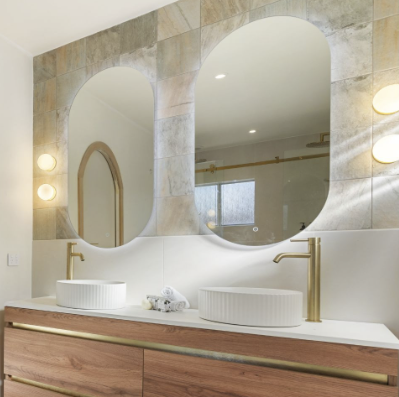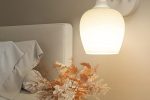Recessed wall lights, often referred to as wall sconces or recessed fixtures, are lighting solutions that are installed into the wall itself, creating a sleek and unobtrusive appearance. Unlike traditional light fixtures that protrude from the wall, recessed wall lights are embedded within the wall structure, allowing for a clean and modern aesthetic. These fixtures typically consist of a housing unit that is mounted within the wall cavity, with a trim that is flush with the surface.
The light source, which can be LED, incandescent, or fluorescent, is positioned within this housing, directing light either upwards or downwards, depending on the design. This innovative approach to lighting not only saves space but also enhances the overall design of a room by minimizing visual clutter. The functionality of recessed wall lights is equally impressive.
They can be used for various purposes, including ambient lighting, accent lighting, or task lighting. When strategically placed, these fixtures can highlight architectural features, artwork, or specific areas within a room, creating a layered lighting effect that adds depth and dimension. The versatility of recessed wall lights allows them to be integrated into various design styles, from contemporary to traditional.
Additionally, many modern recessed lights Murzondesign come with adjustable features, enabling users to direct the light where it is needed most. This adaptability makes them an ideal choice for both residential and commercial spaces, providing illumination that is both practical and aesthetically pleasing.
Benefits of Recessed Wall Lights: How can they enhance your space?
The Aesthetic Benefits of Recessed Wall Lights
Recessed wall lights offer a sleek and sophisticated look in any environment. By being installed flush with the wall, these fixtures eliminate the need for bulky light fixtures that can disrupt the flow of a room’s design. This minimalist approach not only enhances the visual appeal of a space but also allows for greater flexibility in furniture arrangement and decor placement.
Practical Advantages in Smaller Spaces
The unobtrusive nature of recessed wall lights makes them particularly suitable for smaller rooms where space is at a premium, as they do not take up valuable floor or wall space. This makes them an ideal solution for compact areas, such as apartments, studios, or guest rooms.
Energy Efficiency and Customization
In addition to their aesthetic advantages, recessed wall lights also offer practical benefits in terms of energy efficiency and functionality. Many modern recessed fixtures utilize LED technology, which consumes significantly less energy compared to traditional incandescent bulbs. This not only reduces electricity bills but also contributes to a more sustainable lifestyle by lowering carbon footprints. Furthermore, the ability to control the direction and intensity of light allows homeowners and designers to create customized lighting schemes that enhance mood and functionality.
When selecting recessed wall lights, several factors must be taken into account to ensure that the chosen fixtures align with both aesthetic preferences and functional requirements. First and foremost, it is essential to consider the style of the room where the lights will be installed. Recessed wall lights come in a variety of designs, from sleek and modern to more ornate styles that complement traditional decor.
The finish of the fixtures—whether brushed nickel, matte black, or polished chrome—can also significantly impact the overall look of the space. Therefore, it is crucial to choose fixtures that harmonize with existing elements in the room, such as furniture, color schemes, and architectural features. Another important consideration is the type of lighting required for the specific area.
Different spaces may necessitate varying levels of brightness and types of light distribution. For instance, task-oriented areas like kitchens or home offices may benefit from brighter, focused lighting, while living rooms or bedrooms might require softer ambient lighting for relaxation. Additionally, it is vital to assess the wattage and lumens output of the chosen fixtures to ensure they provide adequate illumination without being overpowering.
Finally, considering energy efficiency ratings and compatibility with dimmer switches can further enhance the functionality and sustainability of recessed wall lights in your home.
Installing recessed wall lights can be a rewarding DIY project if approached methodically and with careful planning. The first step involves determining the ideal locations for your fixtures based on your lighting needs and design preferences. It is advisable to sketch out a layout on paper or use design software to visualize how the lights will interact with other elements in the room.
Once you have established the placement, ensure that there are no obstructions behind the walls where you plan to install the fixtures—this may involve checking for electrical wiring or plumbing. After confirming that your installation area is clear, gather all necessary tools and materials, including a stud finder, drywall saw, electrical wiring, and safety gear such as gloves and goggles. Begin by cutting holes in the drywall according to the size specifications of your recessed fixtures.
Next, run electrical wiring from your power source to each fixture location while adhering to local building codes and safety regulations. Once the wiring is in place, connect it to your recessed lights according to manufacturer instructions before securing them into their respective holes in the wall. Finally, install any trim or decorative elements that accompany your fixtures and test them to ensure proper functionality.
Recessed wall lights offer endless possibilities for creative applications in both residential and commercial settings. One innovative idea is to use these fixtures as part of an art display; by strategically placing recessed lights above or beside artwork or photographs, you can create a gallery-like atmosphere that draws attention to your favorite pieces while enhancing their visual impact. This technique not only elevates the aesthetic appeal of your space but also allows you to showcase personal collections in a sophisticated manner.
Another unique application for recessed wall lights is in creating mood lighting in various areas of your home or office. For instance, consider installing these fixtures along hallways or staircases to provide subtle illumination that enhances safety while adding an elegant touch. In living rooms or bedrooms, recessed wall lights can be used in conjunction with dimmer switches to create adjustable lighting scenarios for different occasions—whether it’s hosting a dinner party or enjoying a quiet evening at home.
Additionally, incorporating colored LED bulbs into your recessed fixtures can further enhance this effect by allowing you to change the ambiance according to your mood or seasonal decor.
Cleaning Recessed Wall Lights
To clean them effectively, turn off the power supply first and use a soft cloth or microfiber duster to gently wipe down surfaces without scratching them. For more stubborn grime or fingerprints on glass lenses, a mild glass cleaner can be used sparingly—just be sure not to apply any liquid directly onto electrical components.
Inspecting and Maintaining Recessed Wall Lights
In addition to routine cleaning, it’s important to periodically check the functionality of your recessed wall lights. This includes inspecting bulbs for signs of wear or burnout and replacing them as needed. If you notice flickering or dimming lights, it may indicate an issue with wiring or connections that should be addressed promptly by a qualified electrician.
Long-Term Benefits of Proper Maintenance
By taking these proactive steps in maintenance and care, you can enjoy beautifully illuminated spaces for years to come.
In an era where sustainability is increasingly prioritized in design choices, recessed wall lights stand out as an eco-friendly lighting option that contributes significantly to energy efficiency. Many modern recessed fixtures utilize LED technology, which consumes up to 80% less energy than traditional incandescent bulbs while providing comparable brightness levels. This reduction in energy consumption not only translates into lower electricity bills but also decreases greenhouse gas emissions associated with power generation.
By opting for LED recessed wall lights, homeowners can make a meaningful impact on their overall energy usage while enjoying high-quality illumination. Moreover, recessed wall lights often have longer lifespans compared to conventional lighting options; LED bulbs can last up to 25 times longer than incandescent bulbs before needing replacement. This longevity reduces waste generated from discarded bulbs and minimizes the frequency of replacements required—further contributing to sustainability efforts.
Additionally, many recessed lighting systems are designed with compatibility for smart home technology, allowing users to control their lighting remotely and optimize usage patterns based on occupancy or time of day. By integrating these advanced features into their homes or offices, individuals can enhance their energy efficiency while enjoying greater convenience and control over their lighting environments.

